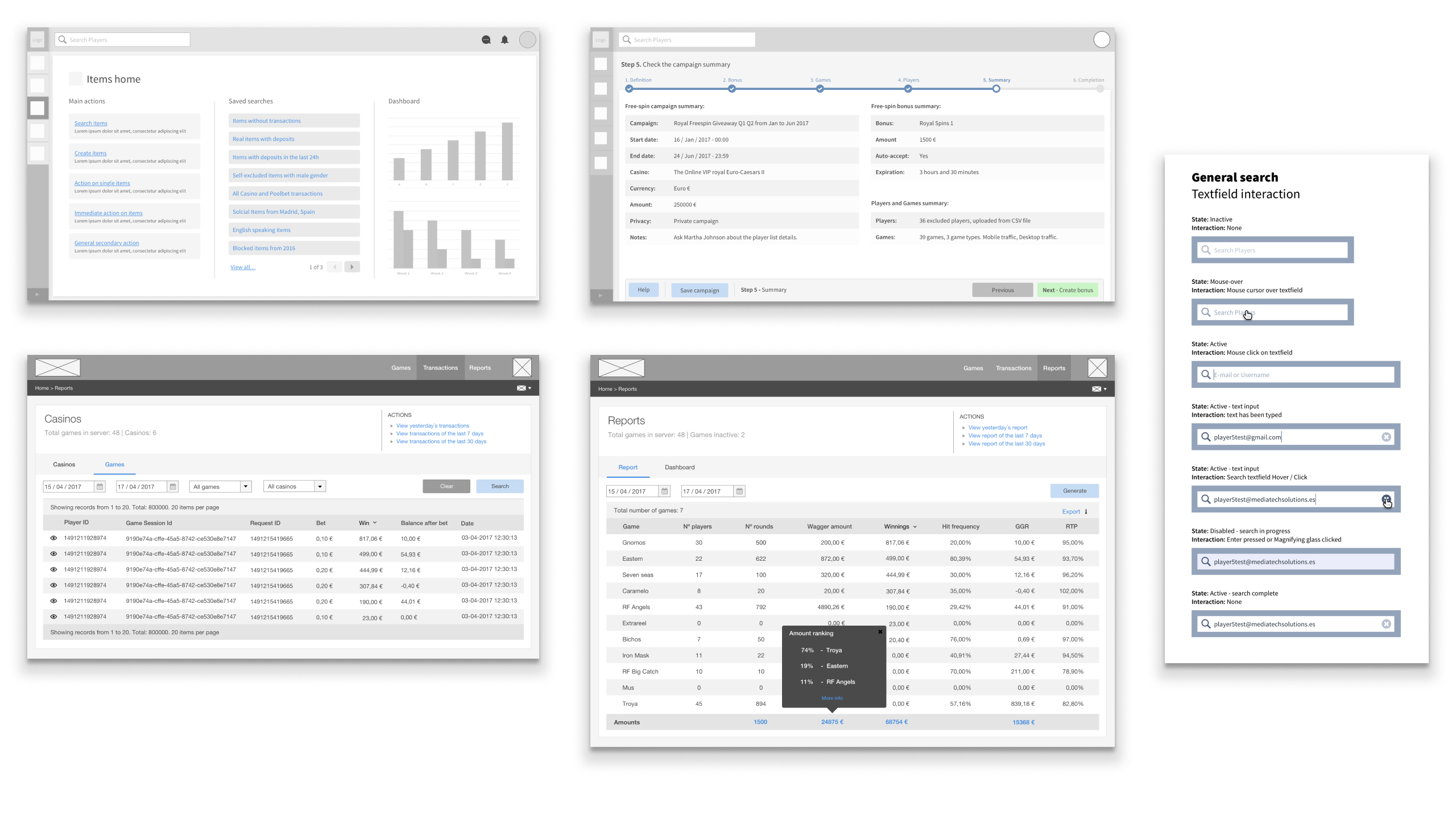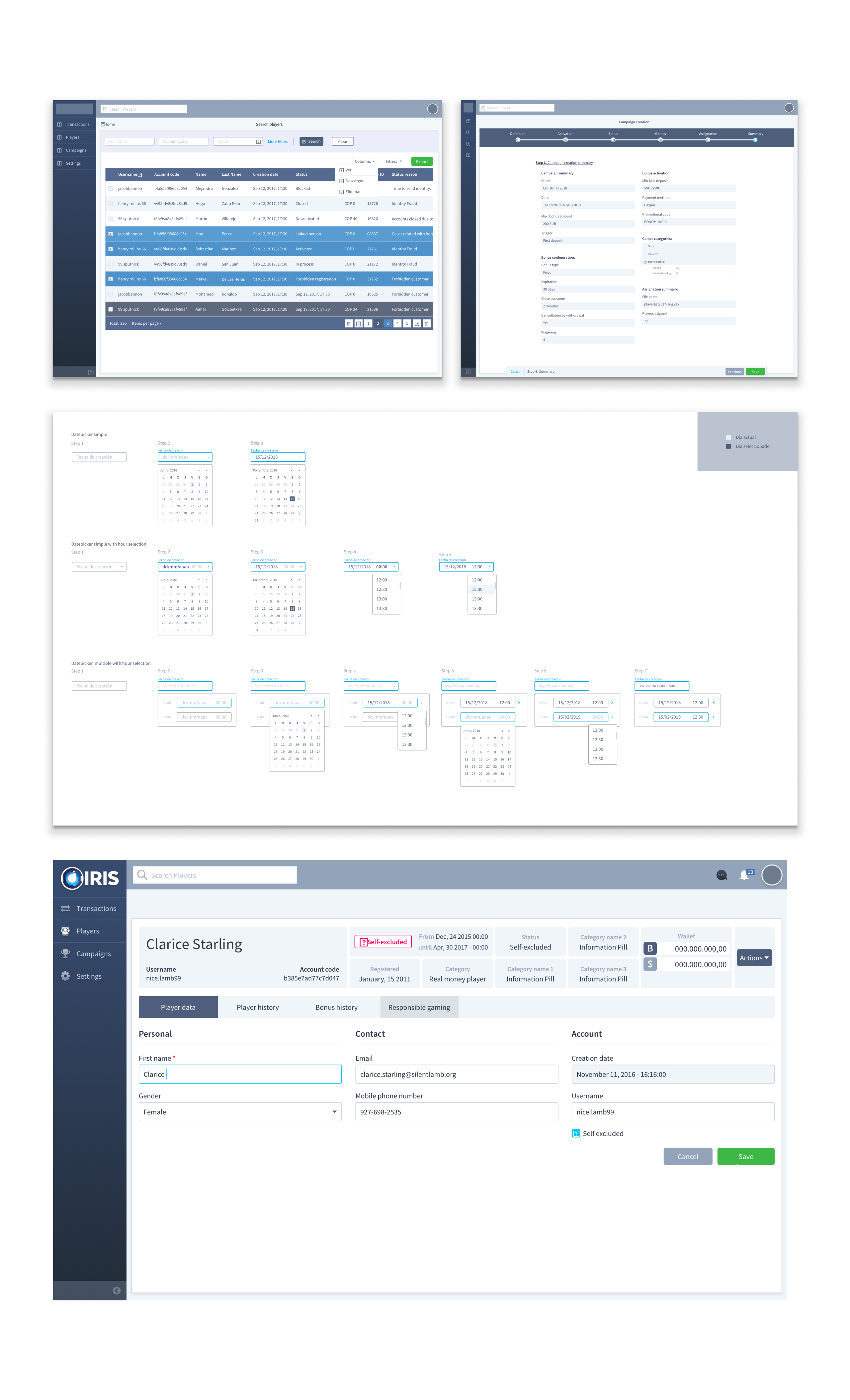IRIS Open Omnichannel Platform
Creating efficient solutions for complex problems in a rapidly changing and highly regulated business.
Overview
- Year: 2017
- Role: Mid/Senior Product Designer, Design Technologist, Design System gobernator.
- Tools: Sketch, Abstract, Jira, Confluence, Hotjar, Adobe Photoshop.
- Description: IRIS Open Omnichannel Platform is a highly scalable and flexible real money and social gaming management tool to power online and retail operations. Designed to centralize all player and monetary activities and provide a hub of tools to grow and retain the customer base, it is the most fundamental piece in gaming operations.
- Design System: In a guild as changing as that of online gaming operators, with continuous changes in legislation, new markets continually opening up, we needed to have a very complete visual ecosystem that would allow us to quickly create the new flows that our customers required. That is why we created BOWL, the design system that gave uniformity to all the digital products of our company and that allowed us to be closely aligned with the development department to be able to bring new functionalities to production with great fluidity.
- Hard Skills: UI/UX DesignDesign System DefinitionDevelopers HandoffProduct Definition
- Soft Skills: CommunicationProblem-solvingUser Centered DesignStakeholder management
Goal
The primary goal of creating a SaaS platform for managing all information of a gambling operator company is to centralize and streamline operations, ensuring compliance with strict regulations while maximizing efficiency and profitability. Key challenges include:
- Developing a robust and scalable system capable of handling vast amounts of real-time data from multiple channels (online, retail, mobile).
- Implementing stringent security measures to protect sensitive player and financial information.
- Ensuring compliance with diverse and ever-changing gambling regulations across different jurisdictions.
- Creating an intuitive user interface that allows operators to easily monitor, analyze, and manage all aspects of their business.
- Integrating various third-party services and payment gateways seamlessly.
Overcoming these challenges is crucial to deliver a comprehensive solution that empowers gambling operators to make data-driven decisions, enhance player experiences, and maintain regulatory compliance in a highly competitive industry.
Empathize
Our design team conducted in-depth interviews with key stakeholders, particularly focusing on representatives from the operations departments of various gambling operator companies. These interviews provided invaluable insights into the day-to-day challenges and needs of our target users. To ensure we were addressing the most critical issues, we collaborated closely with the product owner and development leads to prioritize our work. Through a series of workshops and planning sessions, we analyzed the gathered information, aligning it with technical feasibility and business goals. This collaborative approach allowed us to create a prioritized roadmap that balanced user needs, technical constraints, and business objectives, ensuring that our design efforts were focused on delivering the most impactful solutions for the IRIS Open Omnichannel Platform.
Creation & Validation


Measurement
To measure the benefits of our design solutions, we implemented a comprehensive evaluation process in collaboration with our key stakeholders in the gambling industry. We established clear key performance indicators (KPIs) aligned with business objectives, such as user engagement, operational efficiency, and regulatory compliance. Regular feedback sessions were conducted with platform users to gather qualitative insights, while quantitative data was collected through analytics tools integrated into the IRIS platform. We tracked metrics like user adoption rates, task completion times, and error reduction percentages. Additionally, we monitored the platform's impact on our clients' business performance, including revenue growth and customer retention rates. This data-driven approach allowed us to continuously refine our designs, demonstrate the tangible value of our solutions to stakeholders, and prioritize future development efforts based on real-world impact and user needs.